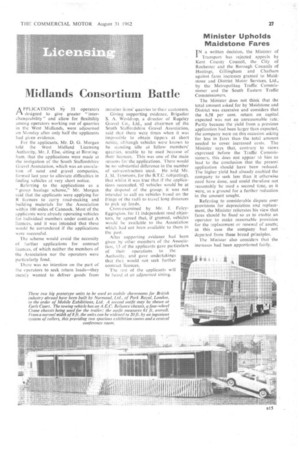Midlands Consortium Battle
Page 29

If you've noticed an error in this article please click here to report it so we can fix it.
A PPLICATIONS by 33 operators I-1 designed to give greater " interchanceability " and allow for flexibility among operators Working out of quarries in the West Midlands, were adjourned on Monday after Only half the applicants had given evidence.
For the applicants, Mr. D. G. Morgan told the West Midland 'Licensing Authority, Mr, J. Else, sitting at Birmingham, that the applications were made at i he instigation of the South Staffordshire Gravel Association, which was an asseciation of sand and gravel companies, formed last year to alleviate difficulties in finding vehicles at very short notice.
Referring to the applications as a " group haulage scheme," Mr. Morgan said that the applicants were applying for B licences to carry road-making and building materials for the Association within 100 miles of Cannock. Most of the applicants were already operating vehicles for individual members under contract A licences, and it was intended that these would he surrendered if the applications were successful.
The scheme would avoid the necessity of further applications for contract licences, of which neither the members of the Association nor the operators were particularly fond.
There was no intention on the part of the operators to seek return loads—they merely wanted to deliver goods from member firms quarries to their customers. Giving supporting evidence, Brigadier S. A. Westdrop, a director of Rugeley Gravel Co., Ltd., and chairman of the
South Staffordshire Gravel Association, said that there were times when it was
impossible to obtain tippers at short notice, although vehicles were known to be standing idle at fellow members', quarries, unable to be used because of their licences. This was one of the main reason; for the applications.. There would be no substantial difference in the number
of sub-contractorS used. He told Mr.
J. M. 'Timmons, for the B.T.C. (objecting), that whilst it was true that if the applica tions succeeded. 92 vehicles would be at the disposal of the group; it was not intended to call on vehicles based on the fringe of the radii to travel long distances to pick up loads.
Cross-examined by Mr. J. FoleyEggington, for 11 independent road objectors, he agreed that, if granted, vehicles would be available to the Association which had not been available to them in the past.
After supporting evidence had been given by other members of the Associa tion, 13 of the applicants gave particulars of their operations to the Authority, and gave undertakings that they would not seek further contract licences.
The rest of the applicants will be heard at an adjourned sitting.




























































































